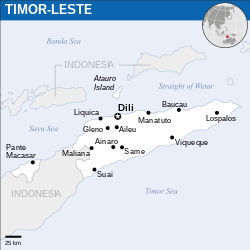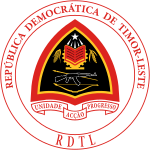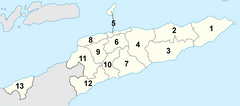East Timor between 1999 and 2002
| East TimorTimor-Leste (Portuguese) Timor Lorosa'e (Tetum) تيمور الشرقية (Arabic) 东帝汶 (Chinese) Timor oriental (French) Восточный Тимор (Russian) Timor oriental (Spanish) | |||||||||
|---|---|---|---|---|---|---|---|---|---|
| 1999–2002 | |||||||||
 Flag
Flag
 Emblem
Emblem
| |||||||||
 Location of East Timor at the end of the Indonesian archipelago. Location of East Timor at the end of the Indonesian archipelago. | |||||||||
| Status | United Nations protectorate | ||||||||
| Capital | Dili | ||||||||
| Common languages | Tetum Portuguese Indonesian English | ||||||||
| Transitional Administrator | |||||||||
| • 1999–2002 | Sérgio Vieira de Mello | ||||||||
| Chief Minister | |||||||||
| • 2001–2002 | Mari Alkatiri | ||||||||
| History | |||||||||
| • UN Security Council Resolution 1272 | 25 October 1999 | ||||||||
| • Independence | 20 May 2002 | ||||||||
| Area | |||||||||
| • Total | 15,007 km (5,794 sq mi) | ||||||||
| Population | |||||||||
| • | 947,000 | ||||||||
| Currency | United States dollar | ||||||||
| ISO 3166 code | TL | ||||||||
| |||||||||
United Nations Administered East Timor refers to the period between 25 October 1999 and 20 May 2002 when East Timor was administered by the United Nations Transitional Administration in East Timor as a United Nations protectorate.
Background
Main article: History of East TimorEast Timor was colonised by Portugal in the mid-16th century and administered as Portuguese Timor. Following the Carnation Revolution in Portugal, East Timor unilaterally declared independence as the Democratic Republic of East Timor on 28 November 1975, but was invaded by Indonesia 7 December 1975. East Timor was occupied by Indonesia and administered as Timor Timur province. The invasion was not recognized as legal by the United Nations, which continued to regard Portugal as the legal Administering Power of East Timor. In 1999, in a UN-sponsored referendum, an overwhelming majority of East Timorese voted for independence from Indonesia. Immediately following the referendum, Pro-Indonesia militias commenced a scorched earth campaign triggering the 1999 East Timorese crisis. An International Force for East Timor was deployed to the territory to bring the violence to an end. Indonesia formally rescinded its annexation on 19 October 1999 and a United Nations transitional administration was subsequently established on 25 October 1999 by Security Council Resolution 1272 to administer the territory until independence on 22 May 2002.
Administrative history
Initial administrative arrangements
A fifteen member National Consultative Council was established in December 1999 by UNTAET REG 1999/2, and served as a forum for East Timorese political and community leaders to advise the Transitional Administrator and discuss policy issues. The Council had eleven Timorese members and four international members. A Transitional Judicial Service Commission was also established to ensure representation of East Timorese leaders in decisions affecting the judiciary in East Timor. The Commission was made up of three Timorese representatives and two international experts.
| Part of a series on the |
|---|
| History of Timor-Leste |
 |
| Chronology |
| Topics |
|
|
First transitional administration
In July 2000 the membership of the National Consultative Council was expanded to 36 members including, one representative from each of the 13 districts of East Timor, and the body was renamed the National Council. All the members were now Timorese and represented the main political parties and religious communities of East Timor. The National Council became a legislature style body and had the right to debate any future regulations issued by UNTAET.
On 15 July 2000, an executive body Transitional Cabinet was formed comprising four Timorese members and four international members.
Progress was made in the development of a judicial system with a Prosecutor General's Office and a Defender Service established. District Courts and Court of Appeal were also established.
A voter registration process was completed during this period and preparations were made for elections to a Constituent Assembly that would prepare East Timor for independence expected in 2002.
Second transitional administration
Elections for an 88-member Constituent Assembly were held on 30 August 2001, the second anniversary of the autonomy referendum, which resulted in a majority of seats for the Fretilin party. The Assembly nominated a transitional Council of Ministers the following month. The Council of Ministers had 24 members and was led by transitional Chief Minister Mari Alkatiri.
The Constituent Assembly completed work on a draft constitution and this was promulgated in March 2002, the Assembly would serve as the parliament of East Timor following independence.
Presidential elections were held in April in which Xanana Gusmão was elected president of a future independent East Timor.
East Timor became an independent state on 20 May 2002.
Office holders
Transitional administrator
Sérgio Vieira de Mello served as Special Representative of the Secretary-General for East Timor (Transitional Administrator) during the period East Timor was administered by the United Nations.
| No. | Portrait | Name (Birth–Death) |
Election | Term of office | Political party | ||
|---|---|---|---|---|---|---|---|
| Took office | Left office | Time in office | |||||
| - | 
|
Ian Martin |
n/a | 25 October 1999 | 19 November 1999 | 25 days | n/a |
| 1 | 
|
Sérgio Vieira de Mello (1948–2003) |
n/a | 19 November 1999 | 20 May 2002 | 2 years, 182 days | n/a |
Chief minister
Mari Alkatiri served as Chief Minister of East Timor between September 2001 and May 2002.
| No. | Portrait | Name (Birth–Death) |
Election | Term of office | Political party | ||
|---|---|---|---|---|---|---|---|
| Took office | Left office | Time in office | |||||
| 1 | 
|
Mari Alkatiri (born 1949) |
2001 | 20 September 2001 | 20 May 2002 | 212 days | Fretilin |
Elections
The following elections were held during United Nations administration:
Local government

During the period of United Nations administration, East Timor was divided into thirteen districts:
- Lautém
- Baucau
- Viqueque
- Manatuto
- Dili
- Aileu
- Manufahi
- Liquiçá
- Ermera
- Ainaro
- Bobonaro
- Cova Lima
- Oecusse
Each district was headed by an UNTAET appointed District Administrator supported by District Advisory Councils with representation from political parties, the Catholic Church, women and youth groups.
Security and law enforcement
Security was initially provided by the International Force for East Timor (INTERFET) but was assumed by UNTAET Peace-Keeping Force (PKF) in February 2000. The formation of an East Timor Defence Force was approved in September 2000 which was formally established in February 2001. At the same time, the pro-independence guerrilla movement FALINTIL was officially disbanded, with many of its members joining the new defence force.
Initially law and order in East Timor was maintained by an international United Nations Civilian Police Force (CIVPOL). Recruitment and training for a local police force commenced by UNTAET in April 2000 and an East Timor Police Service was established in August 2001. Prisons were established at Dili, Becora and Gleno. A Serious Crimes Unit and Crime Scene Detachment also existed to investigate human rights abuses during the period of Indonesian occupation and its immediate aftermath.
International relations
Liaison Offices
Main article: List of diplomatic missions in East TimorThe following countries opened Liaison offices in East Timor during the period of United Nations administration:
Sport
Four East Timorese athletes participated in the 2000 Summer Olympics and two athletes participated in the 2000 Summer Paralympics in Sydney.
Media and communications
UNTAET public information
The UN-led interim administration maintained a local FM radio station, "Radio UNTAET", a TV station, "TV UNTAET" and published a fortnightly newsletter known as "Tais Timor" in English, Portuguese, Tetum and Indonesian.
Postal services
Main article: Postage stamps and postal history of East TimorThe United Nations transitional administration established an East Timor Postal Service in April 2000 with post offices opening in Dili, Baucau and at Comoro Airport. Two postage stamps with the inscription Timor Lorosae / UNTAET were first issued on 29 April 2000, in red for domestic mail and blue for international mail.
-
 UNTAET East Timor domestic and international postage stamps
UNTAET East Timor domestic and international postage stamps
-
 UNTAET East Timor first day cover 29 April 2000
UNTAET East Timor first day cover 29 April 2000
Telecommunications
Main articles: Telephone numbers in East Timor and Telecommunications in East TimorPortuguese Timor used the international dialing code +672 until 1975. During Indonesian occupation, the Indonesian country code +62 was used. The code +672 was subsequently reassigned to the Australian External Territories. Initially after the end of Indonesian occupation, the code +672 9 was used following an agreement with the Government of Australia and telecommunications provider Telstra. East Timor was later assigned the code +670.
See also
- United Nations Transitional Administration in East Timor
- International Force for East Timor
- List of territories governed by the United Nations
- United Nations Administered Kosovo
- United Nations Administered West New Guinea
References
- UNTAET (2 December 1999). "UNTAET Regulation No. 1999/2 On the establishment of a National Consultative Council". peacekeeping.un.org. Archived from the original on 26 February 2020. Retrieved 31 August 2022.
- UNTAET (3 December 1999). "UNTAET Regulation No. 1999/3 On the establishment of a Transitional Judicial Service Commission". peacekeeping.un.org. Archived from the original on 1 July 2019. Retrieved 31 August 2022.
- UNTAET (14 July 2000). "UNTAET Regulation No. 2000/24 On the establishment of a National Council" (PDF). peacekeeping.un.org. Archived (PDF) from the original on 1 July 2019. Retrieved 31 August 2022.
- UNTAET (14 July 2000). "UNTAET Regulation No. 2000/23 On the establishment of the Cabinet of the Transitional Government in East Timor" (PDF). peacekeeping.un.org. Archived (PDF) from the original on 1 July 2019. Retrieved 31 August 2022.
- "UNTAET, East Timor shape new cabinet and legislative body" (PDF). Tais Timor. UNTAET. 24 July 2000. Archived from the original (PDF) on 1 September 2022.
The first session followed the historic announcement...of East Timor's Transitional Cabinet on 15 July at UNTAET Headquarters.
- UNTAET (16 March 2001). "UNTAET Regulation No. 2001/02 On the election of a Constituent Assembly to prepare a Constitution for an independent and democratic East Timor" (PDF). peacekeeping.un.org. Archived (PDF) from the original on 1 July 2019. Retrieved 31 August 2022.
- UNTAET (19 September 2001). "UNTAET Regulation No. 2001/28 On the establishment of the Council of Ministers" (PDF). peacekeeping.un.org. Archived (PDF) from the original on 1 July 2019. Retrieved 31 August 2022.
- Devereux, Annemarie (2015). "Overview of the Constitution-Making Process in Timor-Leste" (PDF). Timor-Leste's Bill of Rights: A Preliminary History. Acton, Australian Capital Territory: ANU Press. pp. 17–60. doi:10.22459/TLBR.05.2015. ISBN 978-1-925022-39-1. JSTOR j.ctt169wd59.7. Archived (PDF) from the original on 11 October 2022. Retrieved 31 August 2022.
- Minister of State Administration (East Timor) (29 July 2003). "Ministerial order no. 6/2003 on the establishment of the number Of Sucos in the national territory" (PDF). Archived from the original on 10 January 2005. Retrieved 31 August 2022 – via UNMISET.
- ^ "UN's Annan hails legal, human rights agreement with Indonesia" (PDF). Tais Timor. UNTAET. 17 April 2000. Archived from the original (PDF) on 1 September 2022.
- UNTAET (31 January 2001). "UNTAET Regulation No. 2001/01 On the establishment of a Defense Force for East Timor". peacekeeping.un.org. Archived from the original on 1 July 2019. Retrieved 31 August 2022.
- UNTAET (10 August 2001). "UNTAET Regulation No. 2001/22: On the Establishment of the East Timor Police Service" (PDF). peacekeeping.un.org. Archived (PDF) from the original on 31 August 2022. Retrieved 31 August 2022.
- ^ "UNTAET, Indonesia sign agreement on border issues" (PDF). Tais Timor. UNTAET. 1 May 2000. Archived from the original (PDF) on 1 September 2022.
- Barker, Philip (25 September 2020). "East Timor trailblazers symbol of unity for Olympic world". Inside the Games. Archived from the original on 24 June 2022. Retrieved 26 March 2023.
- "Tais Timor – Newspaper". www.gov.east-timor.org. UNTAET. Archived from the original on 15 July 2001. Retrieved 3 September 2022.
- "Indonesian President Visits East Timor" (PDF). Tais Timor. UNTAET. 13 March 2000. Archived from the original (PDF) on 31 August 2022.
- "Postage stamp territories – East Timor". Postoveznamky. 26 June 2020. Archived from the original on 31 August 2022. Retrieved 31 August 2022.
- White Book Archived 26 March 2023 at the Wayback Machine, Volume 2, Part 1, International Telegraph and Telephone Consultative Committee, International Telecommunication Union, 1969, page 30
- "Telstra is reconnecting East Timor to the world". Telstra. 21 February 2000. Archived from the original on 21 August 2001.
External links
- Archived web-site of first Transitional Administration
- Archived web-site of second Transitional Administration
- Archived UNTAET website
- UNTAET Legislation
| Timor-Leste articles | |||||
|---|---|---|---|---|---|
| History |  | ||||
| Geography | |||||
| Politics | |||||
| Economy | |||||
| Society |
| ||||
| Current |
|
|---|---|
| Former |
|
| Proposed |
|
- United Nations operations in Timor-Leste
- Government of Timor-Leste
- 1990s in East Timor
- 2000s in Timor-Leste
- States and territories established in 1999
- States and territories disestablished in 2002
- 1990s establishments in East Timor
- 2000s disestablishments in Timor-Leste
- 1999 establishments in Indonesia
- 1999 establishments in Southeast Asia
- 2002 disestablishments in Southeast Asia
- United Nations Security Council mandates
- History of Timor
- Timor-Leste and the United Nations

